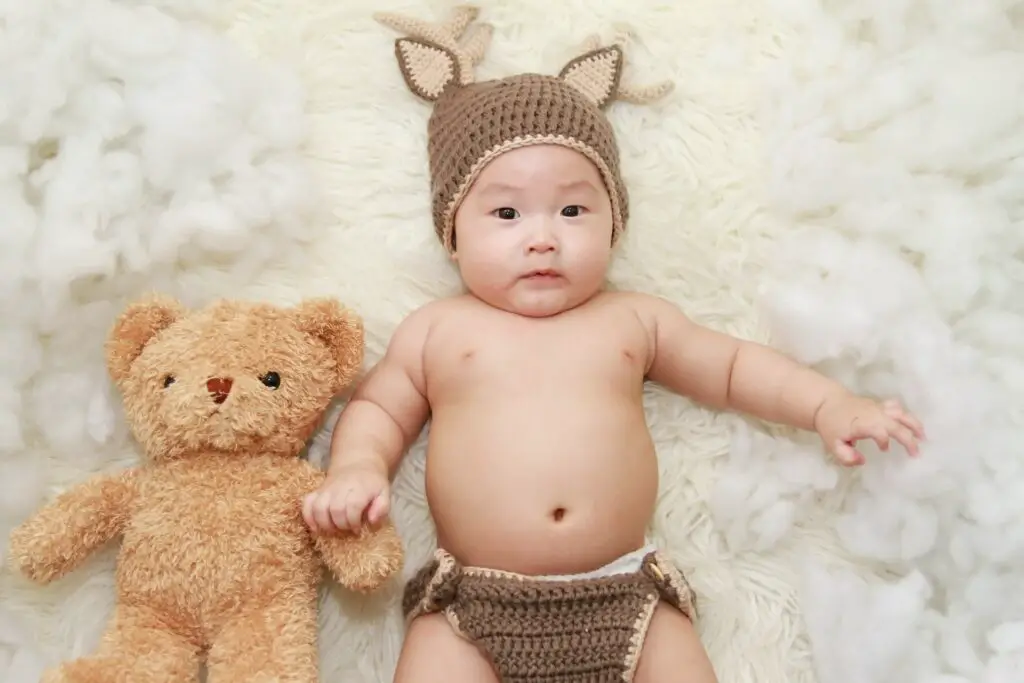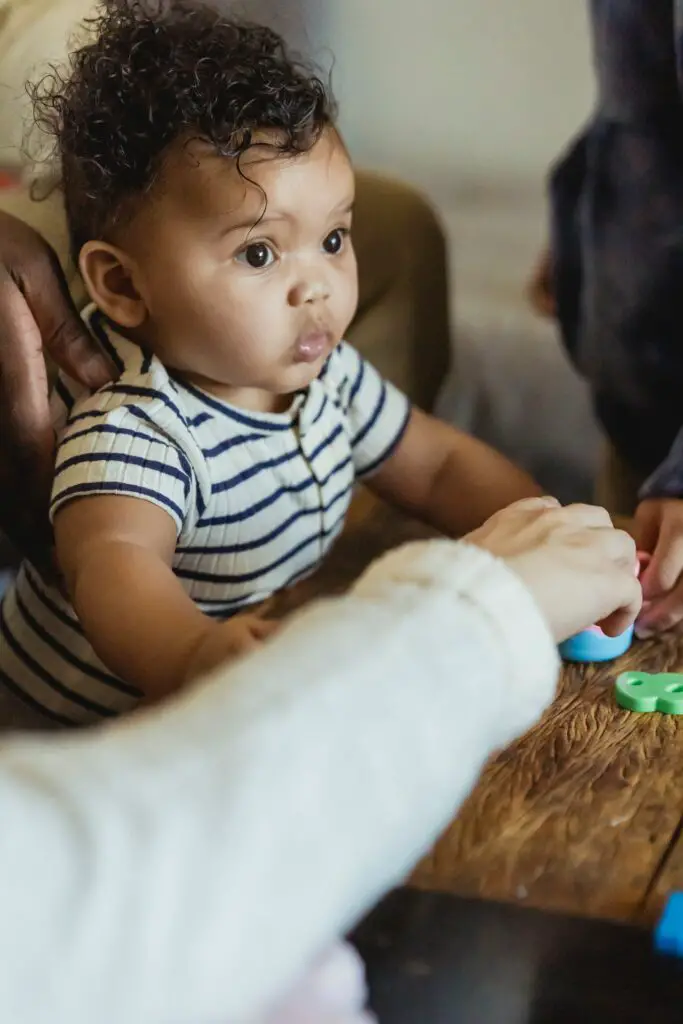Baby Not Interested In Toys?

It can be frustrating when a baby isn’t interested in toys. You might think that a baby isn’t progressing normally if they are not drawn to the colorful, noisy toys that seem to fascinate other babies
But there are many reasons why babies might not be interested in toys. In this blog post, we will explore some of those reasons and offer advice on how to encourage a child’s development even if they are not initially drawn to toys.
Table of Contents
How To Encourage A Baby’s Development?
It is normal for a baby to go through periods where they are not interested in toys or other objects. This usually happens when they are growing and developing new skills. You can do several things to encourage your baby’s development during these times.
First, try to provide a variety of stimulating experiences. This can include different textures to touch, exciting smells, different sounds, bright colors, or even new ways to interact with your child, such as funny facial expressions, singing engaging songs, or reading new stories together.
Additionally, it is crucial to be attentive to your baby’s cues. If they seem tired or frustrated, take a break or try something else. By providing stimulating experiences and being responsive to signals, you can help encourage your child’s development.
Why Do Babies Need Toys?
When you become a parent, you immediately notice that people love to give you advice on what your baby will need. They’ll tell you that you need to get a swing, a bouncer, and a thousand different toys. But what they don’t tell you is that your baby might not be interested in any of those things.
In fact, many babies are content to just lie on their backs and look around at the world. So why do people insist that babies need toys?
There are a few reasons why toys are essential for babies. They are an important part of a child’s life as they help with the baby’s development in many ways.
First of all, they help to stimulate the baby’s senses. Bright colors, exciting textures, and different shapes can all capture the baby’s attention and help them to explore their surroundings.
Toys also provide babies with a sense of security. Having a few favorite toys that they can always count on can help babies feel safe and comfortable in their environment.
Finally, toys encourage the baby to practice important skills such as gross motor skills, fine motor skills, and hand-eye coordination.
So even if your baby might not be interested in toys at first, it’s important to provide them with a variety of stimulating and developmentally appropriate toys. By doing so, you can help babies explore their world, practice essential skills, and feel secure in their environment.
Baby Learning With Toys
Parents often wonder how their babies are learning when it seems like all they do is play. However, research has shown that play is essential for baby development. Through play, babies learn about their environment and begin to develop important skills such as problem-solving, social skills, and motor skills.
Toys are a useful way for babies to explore and learn. Simple toys that can be manipulated in different ways, such as blocks or stacking cups, help babies develop fine motor skills.
Meanwhile, toys that encourage the baby to move around, such as balls or push toys, help with gross motor skills.
By choosing the right toys, parents can give their babies a head start in life and watch them reach their full potential.
When Do Babies Play With Toys?
When babies are born, they are not interested in toys. It is only as they grow and develop that they begin to show an interest in these objects. Babies generally start to play with toys around 6 months of age.
At first, they may simply mouth the toy or bang it against a hard surface. However, as they grow, they will begin to use the toy more creatively. For example, they may shake it, stack it, or roll it across the floor.
This type of play helps babies to develop their fine motor skills and learn about Cause and Effect, which provides them a sense of accomplishment and satisfaction.
Moreover, playing with toys can be a great way for babies to bond with their caregivers. As the baby evolves and develops, so too will their play.
They will start to use toys in more creative ways and will eventually move on to other objects as well.
However, the early months are a crucial time for a baby’s development and so providing them with plenty of opportunities to play with different types of toys is an important thing. This will help them to learn and grow in all the right ways.

Reasons Baby Not Interested In Toys
It’s not uncommon for young babies to lose interest in their toys after a few months. Let’s see why it still might happen.
First, babies grow quickly, and their interests change as they develop new skills. As they become more mobile, they may be more interested in exploring their environment than playing with toys.
Second, babies may become bored with their toys if they are not stimulated by them. If the baby is not challenged or engaged by their toys, they will quickly lose interest in them.
Finally, the baby may outgrow their toys. They may prefer to play with more age-appropriate toys as they get older. If the baby is no longer interested in their baby toys, it’s important to select new toys congruent with your child’s developmental stage.
other reasons can be:
- Maturation level
- Sensory processing disorder
- Other health conditions such as autism
Should I Worry If My Baby Is Not Interested In Toys?
As a baby grows, they begin to show more interest in the world around them. This includes exploring new things and playing with toys. For some babies, this happens sooner than others. But what if your baby seems uninterested in toys?
There are a few things to keep in mind when considering whether or not to worry about your baby’s lack of interest in toys.
First, every baby is different and develops at its own pace. So it’s normal for some babies to take longer to show an interest in playing with toys. And in fact, we sometimes misinterpret the child’s lack of interest in toys.
At tummy time, the effort is especially great, and toys can interest them for a moment, but then most of his energy and attention will focus on dealing with the physical effort of a prolonged stay on the tummy.
Second, even if your baby isn’t particularly interested in toys right now, that doesn’t mean they never will be. Just keep reading and see the different types of toys per age.
Finally, if you are really concerned about your baby’s development, read below the red flags that you should pay attention to according to your baby’s age. If you spot one or more red flags, talk to your pediatrician. They can assess your baby’s development and tell you if there is cause for concern.
Milestones in baby development, age-appropriate toys and red flags!
Baby Development Stages
From the moment of birth, they begin an incredible journey of growth and development. In the first year alone, babies will triple their birth weight, learn to roll over, sit, crawl, and even take their first steps.
The first stage of development is the newborn stage, which lasts from birth to around 2 weeks old. During this time, babies learn to feed, sleep, and regulate their body temperature. They also start to bond with their caregivers and develop a sense of self.
The second stage of development is the infant stage, which lasts from around 2 weeks to 1 year old. During this time, babies learn to sit up, crawl, and walk. They also start to identify sounds and shapes in a baby gym or on a playmat, babble, and use simple words. Additionally, they begin to develop a sense of self-awareness and begin to explore their surroundings.
Let’s look together at the stages of baby development in more detail so we can understand what toys are right for them at each stage and what baby behaviors should raise a red flag!
| Developmental Stage | Appropriate Toys | Red Flag |
|---|---|---|
| 0-2 months of age | Baby doesn’t need toys nor desire toys! | Too soon to detect. Only a professional health care provider can use specific techniques to identify developmental issues. |
| 2-3 months of age | Grabbing toys, noisy toys, tasting toys, tracking moving objects: baby gym, crib mobile. | Does not respond to toys with loud noises and does not watch moving toys. They can not lift their head at tummy time even when they hear their mom’s voice. |
| 3-6 months of age | Safe toys are made of natural materials without sharp edges, soft toys, and toys with different sounds, colors, and textures. | Doesn’t try to get toys and objects within reach, does not respond to toys or things that produce sounds, and has difficulty putting toys or objects in his mouth. |
| 6-12 months of age | Educational toys: activity cube, musical toys, shape sorter, cause and effect toys, etc. | Not playing with interactive toys that move back and forth. Do not respond to their name, do not recognize familiar people, and do not look where the finger is pointing. |
| 1-year-old and up | Standing toys, push walkers, activity table, climbing toys, baby jumper, bouncy toy, balance board, etc. | In addition to those mentioned above, they do not crawl, stand with assistance or lose skills they once had. |

Baby Development Tips
From the moment of birth, they begin a wonderful journey of growth and development. In the first year alone, babies will triple their birth weight, learn to roll over, sit, crawl, and even take their first steps.
It can be exhilarating and overwhelming to watch your little one grow and change so rapidly as a parent. To help you navigate this wonderful time, here are a few important tips for baby development:
- First, don’t be afraid to get messy. From crawling in the dirt to painting with squishy finger paints, babies love exploring the world through their senses. So go ahead and let them get messy! It’s all part of the child’s learning process.
- Second, create a safe and stimulating environment for your baby to explore. This means baby-proofing your home and filling it with age-appropriate toys and books.
- Third, encourage physical activity from an early age. Regular exercise helps babies develop strong muscles and bones, improve their coordination, and promote brain development. It’s essential for the early stage.
- Finally, spend time bonding with your baby every day. Whether it’s reading a book together, singing songs, or just cuddling, this quality time is an important part of your baby’s development.
The Bottom Line
If your baby doesn’t show much interest in toys yet, don’t worry! There are plenty of other activities that will keep them entertained. And remember, every child develops at their own pace – so if your baby is not interested in toys yet, don’t worry! They will get there eventually.
Read also:
- Your Toddler Throws Toys Instead of Playing? Here’s Why
- Best Toys to Help Baby Stand in 2023
- What Are Educational Toys? Essential For Child’s Development!
- Baby Walker vs. Baby Jumper – Which is better?
- Bumbo Floor Seat vs. Fisher-Price Sit-Me-Up – Which one is the Best for your baby?
- Best Baby Safety Helmets for Crawling in 2023
- Best Wooden Balance Board for Toddlers and Kids in 2023
